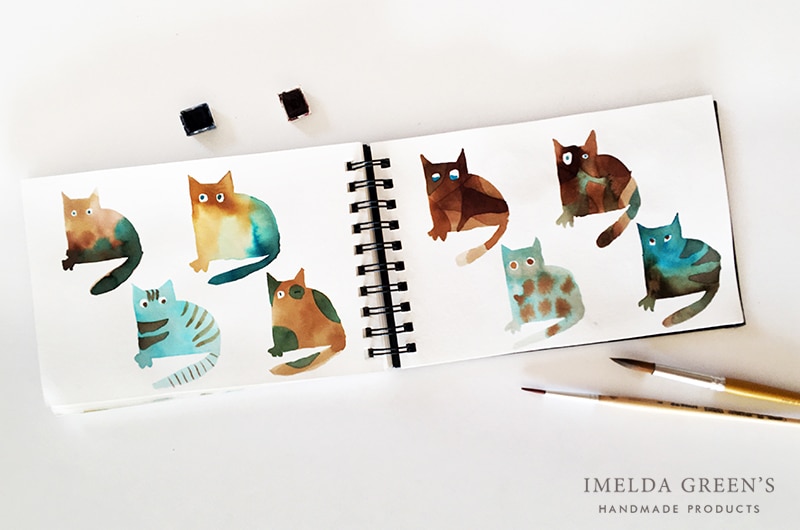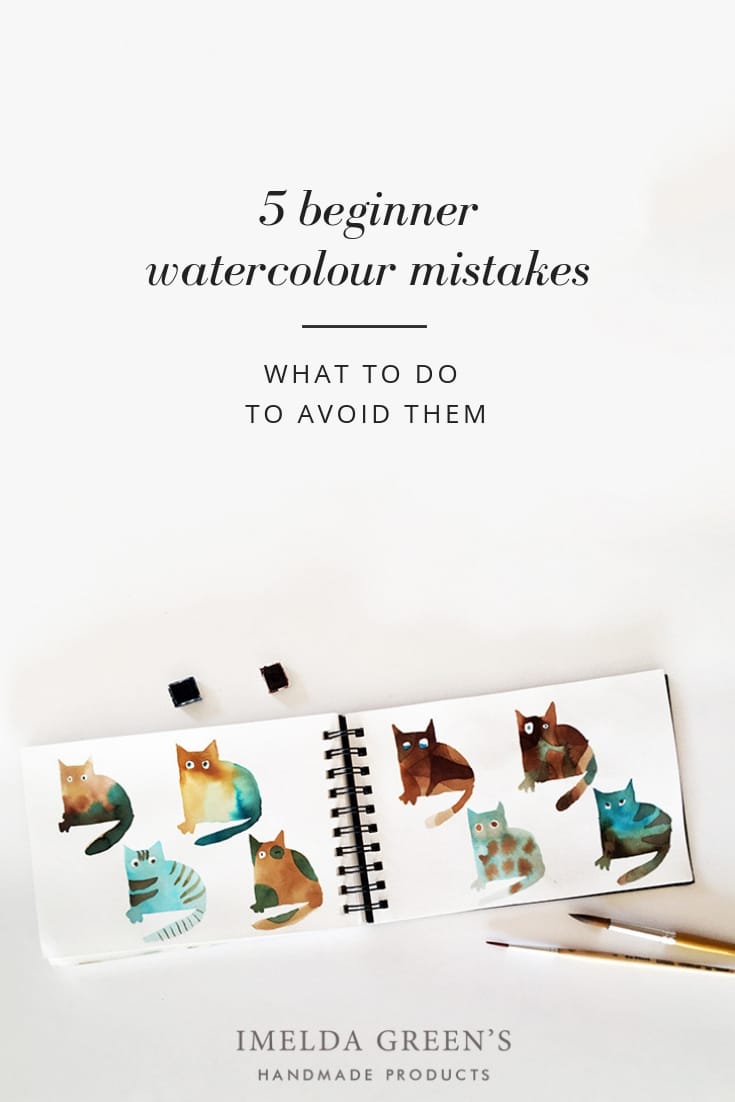
5 beginner watercolour mistakes and how to avoid them
I have been convinced of the benefits of teaching watercolour workshops these past 2 months, but I had hardly thought I would also learn a lot from my students. I tended to overlook some information as being ‘unimportant’ or ‘obvious’, and it turned out they are neither unimportant, nor obvious. So in my experience, these are the mistakes that beginner watercolourists make most often, and here’s how to avoid them.
You are not using watercolour paper
The first and most important thing when you start watercolours is to use watercolour paper. In this medium you use plenty of water, for which simple print paper, or even thicker drawing paper is not suitable, because these types of paper are made of different materials and are unable to absorb as much water as cotton-based watercolour paper. If you want to know more about this topic, read my guide to watercolour paper here.
You are using too small brushes
I currently don’t know anyone, who has not fallen into this trap – including me. It is very tempting to use very small brushes because you can paint wonderfully detailed lines with it, however, you’d better leave this to the end, when you indeed work on details. Painting, as a genre, concentrates on surfaces rather than linework, so you are better off choosing a brush that is suitable for filling surfaces. A bigger brush can hold more water as well as pigment, which means that with one dip in water you can fill a larger area on the paper. The advantage of this is that you don’t have to re-create the exact colour and water/pigment ratio so often. On top of all, round watercolour brushes often have a pointed tip, so if you don’t press too hard, you can create the same fine lines as with a small brush. If you want to know everything about choosing the right brush, read my guide to paintbrushes.
You are not using enough water
You wet your brush, then circle in the paint for long minutes before applying it onto paper? Don’t be surprised if all your colours look black on the paper. This is mostly an issue with higher quality paints with a high amount of pigment, but we have experienced it with aniline paint as well during workshops. Of course, the best pigment/water ratio is different from brand to brand, so you’d better experiment a bit, but watercolour in general is based on using a lot of water – unlike acrylics or gouache – and you can actually achieve vibrant colours using less paint and more water. You don’t have to be afraid of too much water, watercolour paper will take care of that, and if not… read on!
You are dabbing at excess water with a tissue
Even though ‘excess water’ is practically an unknown phrase in the world of watercolour (the paper will absorb it eventually, and the rest evaporates, it’s just a question of patience), it can sometimes happen that you need to quickly get rid of the pond on your paper. In this case, you should definitely avoid dabbing at the paper with a tissue because wet paper – even watercolour paper – is a lot more sensitive than dry, and you can easily damage the surface of the paper. And once damaged, paper cannot heal, it becomes ‘hairy’ at the injured area and there is nothing you can do about it. The good news is that there is another way of dealing with the issue: wash out any paint from your brush (until it leaves no mark on your tissue), dry it on your tissue, then ‘paint’ over the wet area with your dry brush. The brush will act as a sponge, it will absorb all excess water, while being gentle with the surface of the paper. The bigger brush you use the quicker you get rid of all the water, but even with a big brush you’ll probably need to repeat the process a couple of times. Well, watercolour is a matter of patience after all… Talking of which…
You are not waiting long enough for the paint to dry
When 2 surfaces meet – eg. a red petal and a green leaf – you can choose whether you want them to blend into each other or have a clear edge to them. If you choose the latter, it is very important to wait for the first colour (eg. red) to dry before starting on the neighbouring colour (green). If you don’t, the two colours will blend. Watercolour likes to play tricks on the painter and pretend to be dry when in fact it still holds some water between the fibres. If you want to be sure, place your palm on the seemingly dry surface: if it feels cool, it’s still wet. Indeed, it is not easy to wait for surfaces to dry, so I usually try to paint something in the down left corner, and while that dries, finish something in the upper right – so basically I create a time schedule for my painting. :D If that seems a little control-freaky (well…), you can use a hairdryer. In this case you need to blow air from quite far away, because if the wind moves the water on the paper, it will take the pigment with it and potentially ruin the painting. The best thing to do is to blow directly from above, at a distance of at least 60-80 cm.
If you avoid these mistakes, you are on good track with watercolours. If you want to know more tips and tricks, leave a comment below. What kind of problems have you faced with watercolours?



Comments (2)
Kaitlen
January 18, 2019 at 9:59 am
This is a really awesome post. I’ve always wanted to get into watercoloring, but almost to afraid to start for fear that I might mess up. Your tips really put me at ease and I can’t wait to get started! Thanks!
Imelda
January 25, 2019 at 12:22 pm
Best of luck, Kaitlen!